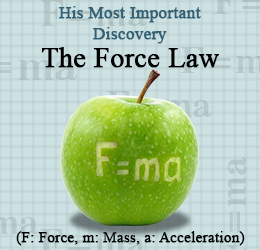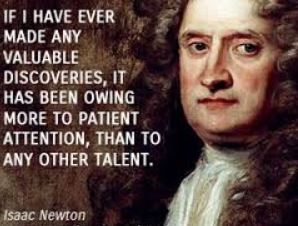 One of the greatest physicists and mathematicians of all time, Isaac Newton’s discoveries and inventions widened the reaches of human thought and demonstrated the power of the scientific way of thinking.
One of the greatest physicists and mathematicians of all time, Isaac Newton’s discoveries and inventions widened the reaches of human thought and demonstrated the power of the scientific way of thinking.
Quick Links:
Newton’s Discoveries
Isaac Newton’s discoveries gave physics its theoretical foundation, granted powerful tools to mathematics and created a launch pad for future developments in science.
I do not know what I may appear to the world, but to myself I seem to have been only like a boy playing on the sea-shore, and diverting myself in now and then finding a smoother pebble or a prettier shell than ordinary, whilst the great ocean of truth lay all undiscovered before me.
– Sir Isaac Newton
This thought offers a rare insight into the workings of great minds like Newton. An inherent curiosity about the world, an appreciation of beauty, the excitement of exploring a mystery and a relentless pursuit of truth are the prime driving forces of a creative mind.
One of the greatest scientists of all time, Sir Isaac Newton’s discoveries led to a deeper understanding of nature and gave physics (known as Natural Philosophy in his time) a firm physical and mathematical foundation.
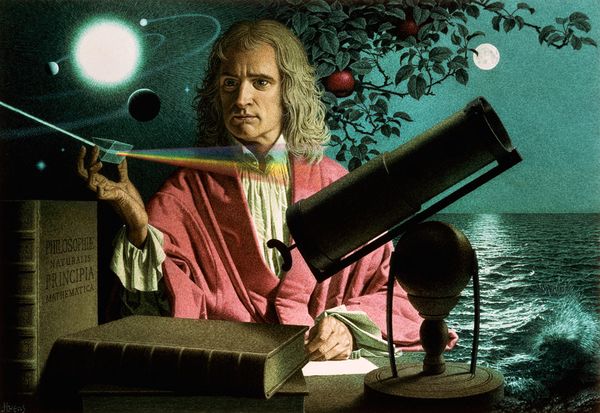
Most Famous Discoveries
- Newton’s three laws of motion set the foundation for modern classical mechanics.
- His discovery of the gravitational force gave man the ability to predict movements of celestial objects, while simultaneously validating Kepler’s laws and the heliocentric Copernican model of the solar system.
- His co-discovery of calculus provided a potent mathematical tool, aiding the precise analytical treatment of the physical world.
Here’s a quick tour of his most important discoveries.
Newton’s Discoveries in Theoretical Physics
Newton’s Magnum Opus – The Principia
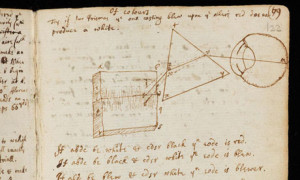
Original manuscript by Sir Isaac Newton, one of several by the English physicist to be made available on the web. Photograph: Cambridge University Library/PA
Sir Isaac Newton contributed to many branches of human thought, among which physics and mathematics were the fields in which he contributed substantially. In 1687, the sum total of his discoveries in mechanics were published in the legendary book Philosophiæ Naturalis Principia Mathematica (Latin for Mathematical Principles of Natural Philosophy).
In this book, (fondly referred to as the Principia by scientists), he synthesized what was known, into a logically whole and consistent theoretical framework, through his laws of motion and theory of gravitation. Creating the great generalizations which bind all the loose threads of clues into a coherent whole, is an art that has been mastered by only a few till date. Sir Isaac Newton was one of them.
The greatest of Newton’s discoveries came when he experienced pristine solitude, in which he could meditate on his vague ideas and assimilate them together into a logically coherent whole. The principle that guided Newton’s discoveries was simplicity. Like Newton, another theoretical physics giant, Albert Einstein was also guided by simplicity and elegance in his thinking about physical laws. One of Newton’s quotes, precisely proves the point;
Read the Principia“Truth is ever to be found in the simplicity, and not in the multiplicity and confusion of things.”
Here are his major contributions to theoretical physics.
The Laws of Motion
- First Law of Motion: An object will continue moving (or staying still) unless acted upon by an external force
- Second Law of Motion: Force = Mass x Acceleration
- Third Law of Motion: When one body exerts a force on a second body, the second body simultaneously exerts a force equal in magnitude and opposite in direction to that of the first body.
Newton’s second law of motion defines a ‘Force’
Newton’s laws of motion defined the concept of inertia and force. They are stated as follows:
- Every object stays in its state of rest or uniform motion, unless disturbed by an external force. (Law of Inertia)
- The force acting on a body is defined as the rate of change of its linear momentum, with time. (Force Law)
- Every action has an equal and opposite reaction. (Action-Reaction Law)
These laws define the effect that the absence or presence of a force has on objects. This troika of axioms defined the framework of mechanics, through which the dynamics of forces and their effects can be analyzed. With these laws, physics made the transition from an empirical field to a science with sound theoretical foundations.
Learn More About Newtown’s 3 Laws of Motion
Discovery of the Law of Gravitation
 A falling apple supposedly made Newton think about the ‘Gravity’ of the situation! (though this may just be a myth started to make his discovery a better story)
A falling apple supposedly made Newton think about the ‘Gravity’ of the situation! (though this may just be a myth started to make his discovery a better story)
While the three laws of motion define a type of mechanics, Newton’s law of gravitation defines the universal force of gravity, whose implications can be studied in the mechanical framework that he created through the laws of motion. The Newton’s law of universal gravitation states that:
Every particle of matter attracts every other particle with a force along the straight line joining them and is directly proportional to their masses, while inversely proportional to the square of the distance between them.
The Law of Gravitation
Using this law and making extrapolations based on it, Newton derived Kepler’s empirical laws of planetary motion, which naturally emerged from his gravitational theory. Many people may have observed apples and all kinds of other things falling down, before Newton, but none of them followed the broad generalization that it represented. Even moon falls towards the Earth and Earth towards the Sun, in the same way! That is what Newton figured out. For the first time, man could understand the motion of planets and satellites and give it a rational explanation.
Newton validated Kepler’s laws and the heliocentric model of the solar system
A paradigm shift brought about by Newton’s law of gravitation was the concept of action at a distance. A gravitational force acts between two particles even though they are not in contact with each other. That is, it manifests as an action at a distance. This concept proved to be the undoing of Newton’s theory later and which was overthrown by Einstein’s theory of General Relativity.
Even though now superseded by general relativity, Newton’s idea of gravitation serves well in understanding the motion of planets and stars to incredible accuracy.
Learn More About Newtown’s Law of Gravity
Discoveries in Optics
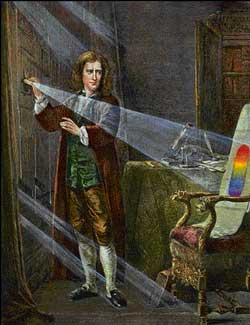 Inquiry into the nature of light – Opticks
Inquiry into the nature of light – Opticks
Newton was fascinated with the field of optics and not surprisingly, made some major discoveries. His prime focus was unraveling the nature of light and its properties. Using prisms and lenses, he studied the refraction and diffraction of light. The description of these experiments and his discoveries detailing light associated phenomena were published in 1706, through the book – Opticks. What the principia did for mechanics, this book did for the field of optics, fundamentally revolutionizing it. Here are some of his most important findings.
► He discovered white light to be composed of component color wavelengths. He demonstrated this with the use of a prism which dispersed a beam of white light into wavelengths of different hues. It’s the same effect which leads to the formation of rainbows in the sky. Through this finding, he overturned the prevalent notion since Aristotelian times which stated that light was inherently white and colorless.
► One of the fundamental problems which Newton explored was – ‘How do various colors arise?’. His experiments revealed that color arose from reflection and transmission of light and primarily from selective absorption of light by materials. From observation of the different angles at which individual wavelengths of light dispersed from a prism, he concluded that color arises from a fundamental property of light itself, though revealed only through interaction with matter.
► A major discovery was the fact that most colors are created from overlapping of certain color components. He also stated the fact which most neuroscientists will agree with today, that human perception of color is essentially a mental phenomenon or subjective experience.
► He predicted the dispersion and aberration of light in telescopes and suggested remedies to correct the same. In the process, he invented a new kind of telescope. Newton promoted the concept of a universal ether through which light propagates. This was later proved wrong by experimental tests of the special theory of relativity.
Newton showed white light to be made of component colors.
► He also put forward the theory that light is made up of corpuscles, which was later proved wrong by Huygens’ wave theory of light. However, the idea got a sort of new life when Einstein introduced light to be made of photons which are energy corpuscles. However, photons are far different from the corpuscles that Newton imagined. Nevertheless, he provided the impetus to new lines of thought.
Newton’s Law of Cooling
Among his other stellar discoveries, Newton also came up with an empirical theory explaining the rate at which your hot cup of coffee cools. The law discovered by him states that the rate of cooling in a body is directly proportional to temperature difference between the body and its surroundings. Mathematically, it can be stated as follows:
dT/dt = – K (T – Ts)
where, T is temperature of the body, K is a constant, dT/dt is a time derivative representing change of temperature and Ts is the temperature of surroundings. (The derivative is ‘negative’ as the body is cooling).
Newton’s Discoveries in Mathematics
Binomial Theorem
Under the tutelage of Isaac Barrow at Cambridge, Newton’s mathematical genius flowered. His first original contribution to mathematics was the advancement of binomial theorem. Through the usage of algebra of finite quantities in an infinite series, he included negative and fractional exponents in the binomial theorem.
Calculus
Isolated during the plague years (1665-1666) at Woolsthorpe Manor, Newton came up with his greatest breakthroughs in physics and mathematics. Through invention of Infinitesimal Calculus, (credit for which also belongs to Leibniz), Newton provided a mathematical framework which enabled the study of continuous changes. He called it the Science of Fluxions. The invention of calculus ranks right up there with invention of fire or the building of the first steam engine. His approach to calculus was geometrical, in contrast to Leibniz, who was inclined more towards the analytical side.
Newton-Raphson Method
He also made contributions to numerical analysis in the form of the Newton-Raphson method. In the book, De analysi per aequationes numero terminorum infinitas (Latin for On analysis by infinite series), published in 1771, Newton described this iterative method of approximation to calculate roots of real-valued functions. The method is described by the following formula.
xn+1 = xn – f(xn) / f'(xn)
where xn+1 is the root calculated from the n+1th iteration, xn is approximate root from the previous iteration, f(xn) is the function to be solved and f'(xn) is the derivative of the function.
Newton’s Inventions
Newton wasn’t just an abstract theoretician, but also a practical experimenter, as his research in optics reveals. Here are some of his widely and lesser known inventions, besides his lofty theoretical physics triumphs.
Most Famous Inventions
- One of Isaac Newton’s inventions is the reflecting telescope, which was his entry card into the premier Royal Society of London.
- The perfect coin
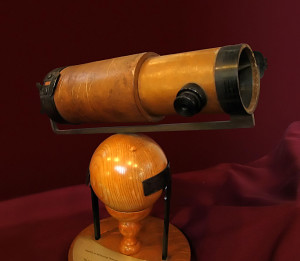
A replica of Newton’s second reflecting telescope, which he presented to the Royal Society in 1672.
Reflecting Telescope
Newton’s Reflecting Telescope
During his investigation in optics, Newton also developed an alternative telescope design, which side-stepped some of the inherent flaws of the prevalent refraction-based design. What is now known as the Newtonian telescope is designed with a paraboloid mirror at the base which reflects the incoming light onto a slanted flat secondary mirror. This flat mirror ultimately reflects the collected light to an eyepiece for observation. Besides solving the problem of chromatic aberration – the bane of refracting telescopes, it is also comparatively cheaper to build.

Check out those fancy milled edges
The Perfect Coin
Working as Warden at the Royal Mint, Newton recalled all English coins and had them melted down and remade into a higher-quality, harder-to-counterfeit design. It was a bold move, considering that the entire country had to make do without a currency for an entire year. You know those ridges on the edge of a U.S. quarter? Those are milled edges, a feature introduced by Newton on English coins to prevent clipping.
Cat Doors
The invention of the pet door, now a common feature in many American or European homes is often attributed to Newton, who supposedly came up with the idea, to allow his pet cats to travel in and out without disturbing him. Though this claim stays unsubstantiated and the sources are largely anecdotal, it makes for an interesting addition to Newton’s repertoire of inventions.
We have covered the most important of Newton’s inventions and discoveries in theoretical physics, which have led to a radical change in our view of the world. It is amazing to think of what he was able to accomplish, most of which before the age of 26 and all of which by 40 when we moved his focus from science to religion. Some scientists today even joke that they’re glad he didn’t keep working on physics or he would have solved all it’s questions and left nothing for the rest of us! =)
I leave you with a gem of a thought, from the man himself.
No great discovery was ever made without a bold guess.
― Isaac Newton
Source: http://www.buzzle.com/articles/isaac-newtons-discoveries.html

